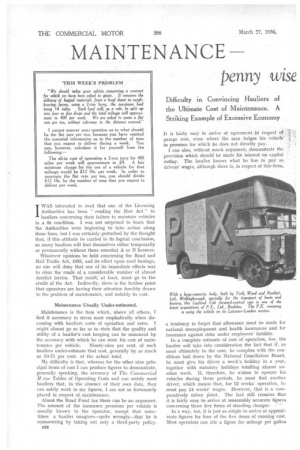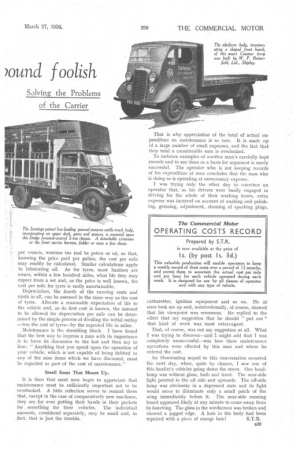MAINTENANCE
Page 42

Page 43

If you've noticed an error in this article please click here to report it so we can fix it.
penny wise
)ound foolish
IWAS interested to read that one of the Licensing Authorities has been "reading the Riot Act" to hauliers concerning their failure to maintain vehicles in a fit condition. I was not surprised to learn that the Authorities were beginning to take action along those lines, but I was certainly perturbed by the thought that, if this attitude be carried to its logical conclusion, so many hauliers will find themselves either temporarily or permanently without those essential A or B licences.
Whatever opinions be held concerning the Road and
• Rail Traffic Act, 1933, and its effect upon road haulage, no one will deny that one of its immediate effects was to clear the roads of a considerable number of almost derelict lorries. That result; at least, must go to the credit of the Act. Indirectly, there is the further point that operators are having their attention forcibly drawn to the problem of maintenance, and notably its cost.
Maintenance Usually Under-estimated.
Maintenance is the item which, above all others, I find it necessary to stress most emphatically when discussing with hauliers costs of operation and rates. I might almost go so far as to state that the quality and utility of a haulier's cost keeping can be measured by the accuracy with which he can state his cost of main
tenance per vehicle. Ninety-nine per cent, of such hauliers under-estimate that cost, generally by as much as 50-75 per cent, of the actual total.
My difficulty is that, whereas for the other nine principal items of cost I can produce figures to demonstrate, generally speaking, the accuracy of The Commercial 1 _dor Tables of Operating Costs and can satisfy most hauliers that, in the absence of their own data, they can safely work to my figures, I am not so fortunately placed in respect of. maintenance.
About the Road Fund tax there can be no argument. The amount of the insurance premium per vehicle is usually known to the operator, except that sometimes a haulier imagines—quite wrongly—that he is economizing by taking out only a third-party policy. B28 It is fairly easy to arrive at agreement in respect of garage rent, even where the man lodges his vehicle in premises for which he does not directly pay. I can also, without much argument, demonstrate the provision which should be made for interest on capital outlay. The haulier knows what he has to pay as drivers' wages, although there is, in respect of this-item, a tendency to forget that allowance must be made for national unemployment and health insurances and for insurance against risks under employers' liability.
In a complete estimate of cost of operation, too, the haulier will take into consideration the fact that if, as must ultimately be the case, he complies with the conditions laid down by the National Conciliation Board, he must give his driver a week's holiday in a year, together with statutory holidays totalling almost another week. If, therefore, he wishes to operate his vehicles during those periods, he must find another driver, which means that, for 52 weeks' operation, he must pay 54 weeks' wages. However: that is a comparatively minor point. The fact still remains that it is fairly easy to arrive at reasonably accurate figures concerning those five items of standing charges.
In a way, too, it is just as simple to arrive at appriakimate figures for four of the five items of running COst. Most operators can cite a figure for mileage per gallon per. ventcle, whether the fuel be petrol or oil, so that, knowing the price paid per gallon, the cost per mile may readily be calculated: Similar calculations apply to lubricating oil. As for tyres, most hauliers are aware, within a few hundred miles, what life they may expect from a set and, as the price is well known, the cost per mile for tyres is easily ascertainable.
Depreciation, the fourth of the running costs and ninth in all, can be assessed in the same way as the cost of tyres. Allocate a reasonable expectation of life to the vehicle and, as its first cost is known, the amount to be allowed for depreciation per mile can be determined by the simple process of dividing the initial outlay —less the cost of tyres—by the expected life in miles.
Maintenance is the stumbling block. I have found
• that the best way to impress a man with its importance is to leave its discussion to the last and then say to him : "Anything that you spend upon the operation of your vehicle, which is not capable of being debited to any of the nine items which we have discussed, must be regarded as part of the cost of maintenance."
Small Sums That Mount Up.
It is then that most men begin to appreciate that maintenance must be sufficiently important not to be overlooked. A little reflection serves to remind them that, except in the case of comparatively new machines, they are for ever putting their hands in their pockets for , something for their vehicles. The individual amounts, considered separately, may be small and, in , fact, that is just the trouble. That is why appreciation of the total of actual expenditure on maintenance is so rare. It is made up of a large number of small expenses, and the fact that they total a considerable sum is overlooked.
To instance examples of another man's carefully kept records and to use them as a basis for argument is rarely successful. The operator who is not keeping records of his expenditure at once concludes that the man who is doing so is operating at unnecessary expense.
I was trying only the other day to convince an operator that, as his drivers were busily engaged in driving for the whole of their working hours, extra expense was incurred on account of washing and polishing, greasing, adjustment, cleaning of sparking plugs, carburetter, ignition equipment and so on. He at once took me up and, unintentionally, of course, showed that his viewpoint was erroneous. He replied to the effect that my suggestion that he should " put out" that kind of work was most extravagant.
That, of course, was not my suggestion at all. What I was trying to discover—and I might add that I was completely unsuccessful—was how these maintenance operations were effected by this man and where he entered the cost.
An illuminating sequel to this conversation occurred the next day, when, quite by chance, I saw one of this haulier's vehicles going down the street. One headlamp was without glass, bulb and front. The near-side light pointed to the off side and upwards. The off-side lamp was obviously in a depressed state and its light would serve to illuminate only a small patch of the wing immediately before it. The near-side running board appeared likely at any minute•to come away from its fastening. The glass in the windscreen was broken and showed a jagged edge. A hole in the body had been repaired with a piece of orange box ! S.T.R.




























































































